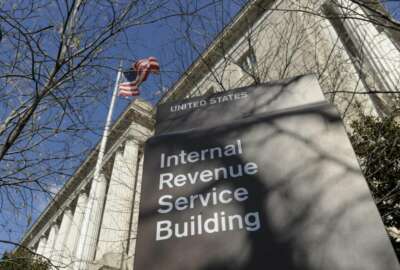
IRS gets $80B to ‘rebuild’ its capacity under Senate reconciliation deal
The budget reconciliation package announced Wednesday night by Senate Majority Leader Chuck Schumer and Sen. Joe Manchin (D-W.Va.) would give the IRS $80 billion...
Best listening experience is on Chrome, Firefox or Safari. Subscribe to Federal Drive’s daily audio interviews on Apple Podcasts or PodcastOne.
The IRS gets another shot at long-term investment in its enforcement and taxpayer services.
The budget reconciliation package announced Wednesday night by Senate Majority Leader Chuck Schumer (D-N.Y.) and Sen. Joe Manchin (D-W.Va.) would give the IRS $80 billion over the next 10 years, with a focus on tax enforcement.
Schumer said Wednesday he expects the Senate to vote on the budget reconciliation bill next week.
The 2022 Inflation Reduction Act would help shrink a growing tax gap between what taxpayers owe and what the agency collects.
IRS Commissioner Chuck Rettig told Congress last year the tax gap may be as high as $1 trillion a year.
The package also gives the Postal Service $3 billion in funding for electric vehicles and charging infrastructure.
The Biden administration and congressional Democrats first included these spending proposals in the Build Back Better Act, but Manchin eventually rejected the deal. His role in drafting this similar, but less expensive package, improve its chances of passing the Senate.
President Joe Biden said Thursday the bill has “a lot of similarities” compared to the Build Back Better Act.
“It’s not all of it, but we’ve moved a long way,” Biden said.
The IRS would have until Sept. 30, 2031, to spend the money.
The IRS would see $45 billion toward its enforcement operations, and $25 billion would go toward operations support.
Another $4.75 billion would go toward its six-year IT modernization effort. If the spending bill passes, the IRS would finally have access to the multi-year funds it says are needed to make more progress on its IT modernization goals.
A recent IRS report found the agency experienced over 100 continuing resolutions since 2001, and funding uncertainty forces the agency to opt for “more expensive, less effective, short-term solutions” when it comes to IT modernization.
More than $3 billion would go toward taxpayer services. The bill would also give the IRS $15 million to prepare and deliver a report to Congress on the cost of developing and running a free direct e-file tax return system.
The National Treasury Employees Union said the IRS lost 8,645 customer service representatives from 2010 to 2020, “hampering the ability to respond to taxpayer phone calls.”
NTEU National President Tony Reardon said in a statement Thursday the $80 billion investment will help the IRS “catch tax cheats and narrow the gap between what is owed and collected every year.”
“NTEU has long argued that a fully funded, fully staffed IRS is a potent tool for deficit reduction because of the tax revenue that is left on the table each year,” Reardon said. “However, we at NTEU are equally enthusiastic about how this investment would revolutionize customer service for all American taxpayers who need extra help in meeting their tax obligations.”
A bill summary states the IRS would allow the Treasury secretary “greater flexibility with respect to personnel,” including direct hire authority the IRS received this year.
A Congressional Budget Office report last year found the IRS would more than double its workforce under this spending plan. The agency recently told Congress it had 33,000 fewer employees in 2020 than it did a decade ago.
The bill summary expects the IRS, with these investments, will raise $124 billion in additional revenue over the next 10 years.
The IRS would have nine months after the legislation passes on the cost of developing and running a direct e-file system “including costs to build and administer each release, with a focus on multi-lingual and mobile-friendly features and safeguards for taxpayer data.
The report would require an independent third-party to review and provide input on the “overall feasibly, approach, schedule, cost, organizational design and Internal Revenue Service capacity to deliver such a direct e-file return system.”
A summary of the bill describes the $80 billion as an effort to “rebuild the IRS.”
“Every year, hardworking American families pay their taxes on time while wealthy millionaires and billionaires avoid paying the taxes they owe to the federal government. The IRS needs resources to tackle this challenge,” the summary states.
In a blog post Thursday, IRS Chief Information Officer Nancy Sieger said the agency will update its six-year IT modernization plan in the coming months “with a view of existing modernization programs and future plans that can be scaled up or down based on available resources.”
“Our vision includes personalized online accounts for individuals, businesses and tax professionals that are simple to use and navigate and seamless updates to IRS systems when tax laws change,” Sieger wrote.
In a report earlier this month, the IRS said American Rescue Plan funds will help it complete the modernization of the Individual Master File, the system it uses to store and process tax returns.
Sieger said the IRS has converted over 90% of the core legacy code for processing individual income tax returns to Java, with the goal of finishing this portion of the work in fiscal 2023.
The Individual Master File, created in the 1960s by IBM, is coded in Assembly Language Code and COBOL, programming languages that are no longer commonly taught. It’s one of the oldest legacy systems still running in the federal government.
“When the conversion is complete and tested, the IRS will no longer be reliant on legacy code for core individual tax processing. This means that for future system changes, the updates will be done in Java programming language, which any trained developer can use. This achievement will also help us recruit, hire and train the people we need to run our modernized tax systems more readily,” Sieger said.
USPS electric fleet plans to ‘evolve upward’ under $3B spending plan
The bill would also give the Postal Service $3 billion to purchase electric vehicles and charging infrastructure.
The bill summary describes the $3 billion in USPS spending as part of a larger $9 billion investment in “federal procurement of American-made clean technologies to create a stable market for clean products.”
The funding from Congress would give USPS greater purchasing power for an electric fleet, compared to what the agency could afford on its own.
USPS recently announced it will, for now, only plan to buy the 50,000 next-generation delivery vehicles (NGDVs) it ordered in March, the minimum outlined in its contract with Oshkosh Defense.
The agency, however, now ensures no less than 50% of those custom-built vehicles will be electric vehicles.
To replace its aging vehicle fleet more immediately, USPS plans to purchase 34,500 commercial off-the-shelf (COTS) vehicles over a two-year period.
All told, USPS expects 40% of these 84,500 vehicles will be electric.
Postmaster General Louis DeJoy told reporters Wednesday this vehicle acquisition strategy gives USPS more flexibility to purchase electric vehicles “as the market develops.”
“It doesn’t mean we won’t buy more. It just means we evaluate every year,” DeJoy told reporters.
USPS spokeswoman Kim Frum said Thursday that, “based on improvements in operational, technology and financial circumstances we expect the electric portion of our fleet to evolve upward.”
“We have been monitoring the interest of Congress in funding an increase in electrification and should funding be enacted we will assess the impact on our plans,” Frum said.
Copyright © 2024 Federal News Network. All rights reserved. This website is not intended for users located within the European Economic Area.
Jory Heckman is a reporter at Federal News Network covering U.S. Postal Service, IRS, big data and technology issues.
Follow @jheckmanWFED
Related Stories

IRS may be able to double IT modernization workload with COVID funds




